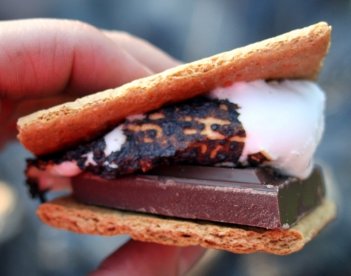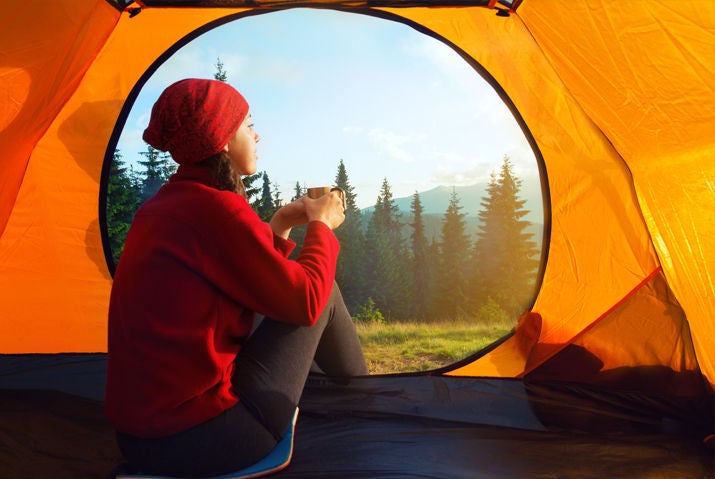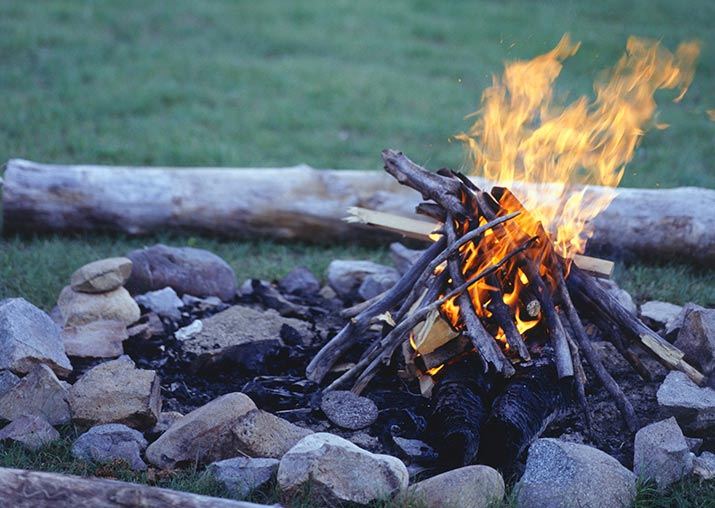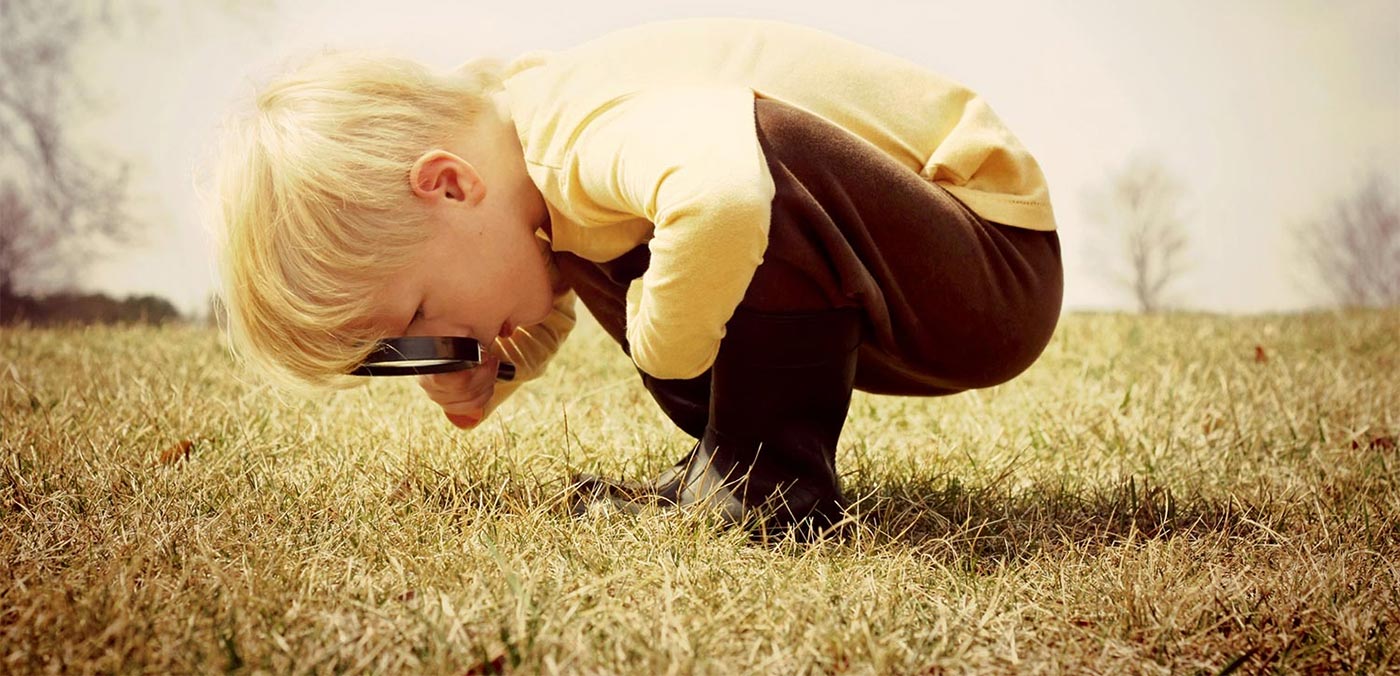There are so many fantastic activities and adventures you can enjoy while camping. Check out some ideas below on how to make your camping experience unforgettable and fun for the whole family.
- How to Make a Fire
- Cooking Outside
- S’mores – A Camping Must-have
- Meal Ideas
- How to Store Food at Your Campsite
- Leave-No-Trace Camping
- Star Gazing
- Storytelling
- Camp Songs
- Geocaching
- Bioblitz
- Camping Tricks
How to Make a Fire
Our thanks to Ann & Sandy Cross Conservation for the information below.
- Fire bans: Check the provincial parks website for fire bans in the area that you will be camping. If it is a private campsite, you can call ahead for more information.
- Hazard check: Before you start a fire, look around your area to ensure that there is nothing extremely flammable near your fire area. Also add water to a wash basin or a small bucket to put out any stray embers quickly.
- Start small: All fires start small. Bring newspaper with you and crunch it up into fist-sized balls. Stack a few of them into the centre of the fire pit. Next, take small bits of wood (kindling) and lean them against and on top of the paper. Fire needs oxygen, so make sure that there is enough space for air to get in.
- Slow and steady: Gradually add larger bits of kindling, eventually moving up to split logs. It may take as long as 15 minutes for a small fire to grow to a reasonable-sized campfire.
- Coals: The best campfire is one with a small flame and lots of hot coals. Usually a fire has to burn for at least 20 minutes before the embers are at a good level for cooking.
- Put it out: When you are done with your campfire, make sure you put it out. Ashes can continue to burn for more than 24 hours after the fire has been put out, even if you can’t see any flames. For this reason, make sure that you douse the fire with lots of water, then stir up the ashes and douse it again.
One of the great joys of camping is roasting hot dogs and marshmallows over a roaring campfire. While these foods are staples for any camping trip, it’s important to pack nutritious and filling foods as well to fuel everyone for all of the fun activities and adventures you will enjoy while kicking back in the wilderness.
Tips for packing food for your camping trip:
- Plan your meals. Not only will this save you time during meal preparation, but it will also ensure that you bring enough food for the duration of your trip. Plan the meals with as much or little detail as you like, making your pre-camping shopping trip that much easier.
- Bring supplies in smaller containers. Put small portions of sauces and spices in tightly sealed containers and label each one for easy access.
- Label all of your foods. You may be camping with people who have allergies, so labels are very important. Always pack allergy medicine, just in case.
- Prepare side dishes and toppings in advance.
- Prepare your first lunch before you leave home so you can enjoy your first camping adventure without worrying about food.
S’mores – A Camping Must-have
 A s’more is a classic campfire treat! It’s a graham cracker, roasted marshmallow and chocolate squished together into warm, gooey goodness.
A s’more is a classic campfire treat! It’s a graham cracker, roasted marshmallow and chocolate squished together into warm, gooey goodness.
You’ll need:
A campfire
Graham crackers
Chocolate
Marshmallows
Roasting sticks
Time:
Five minutes
- Start with a campfire. The wood should be dry and free of paint or preservatives. Do not use chemicals when building your fire, especially if you are planning to cook food over it.
- You’ll need graham crackers (any brand will do). Two crackers are required for one s’more.
- You’ll also need some chocolate. Break a bar into smaller pieces and place one or two of these small chocolate pieces on one cracker.
- Carefully insert a roasting stick into the base of a marshmallow and push it halfway through. They sell sticks for campfire cooking at many retailers including SAIL, Canadian Tire, Walmart, Home Hardware – or you could use a stick near your campsite as long as the stick is long enough to reach to the centre of your fire. You can carefully trim the end of the stick with a knife to make sure the tip is clean.
- Cooking over the fire embers (or glowing coals) works best. Suspend your marshmallow 8 to 30 centimetres above the coals of the fire, keeping hands and clothing away from the fire or heat. Rotate the marshmallow slowly. When the marshmallow is lightly browned, remove from heat.
- Immediately place the hot, melted marshmallow on top of the base cracker and chocolate. Squish the second graham cracker over the warm marshmallow and pull out the roasting stick.
- Wait for a second or two, and eat.
For video instructions on making s’mores, check out this WikiHow page:
wikihow.com/Make-a-S'more
Want some variety? Try replacing the plain chocolate with pieces of your favourite candy bar!
Meal Ideas
Check out some fast and fun recipes you can make with your family before you camp!
BREAKFAST
“Get up & Go” bars
No-Bake Granola Bars
Pumpkin Oatmeal
Camping Omelet
LUNCH
Tomato Sandwiches
The Ultimate Patty Melt
Wrap Sandwiches (Many options here!)
DINNER
Campfire Baked Potatoes (Make these as simple or as elaborate as you like!)
Easy BBQ chicken
Campfire Pepperoni Pizza
Campfire Stew
DESSERTS & SNACKS
Camping Banana Boat
S’mores
Brown Bears
Apples by the Fire
Campfire S'mores Bread Pudding #BBFeggs
How to Store Food at Your Campsite
It’s Getting Hot Out Here
If you’re camping during the summer months, it’s a great idea to invest in a cooler filled with ice, ice-packs or frozen foods to keep your items fresh and nutritious for days at a time. Bringing frozen food in the cooler means that you don’t have to take up as much space with ice. Many campgrounds sell ice on-site or feature nearby amenities to assist with keeping your foods chilly.
Almost all recreational retailers, including SAIL, Canadian Tire, Walmart and Home Hardware, sell coolers, and many grocery stores sell coolers during the summer months.
It’s Mine; You Can’t Have It
It is important to remember that when you are out exploring nature, there’s a chance nature is exploring you too! Especially when you’re cooking on their turf.
Wildlife are curious about new smells and foods nearby. To be sure your food supply isn’t at risk of wildlife burglary, secure your items in a cooler. For extra security, wrap a bungee cord around your cooler or put your food in your car for the night, if you happen to have a vehicle nearby.
No Scraps, Please
Although they're biodegradable, peels and cores shouldn't be left behind. If you leave them out in the open, they'll be an eyesore, and if you bury them, something's probably just going to dig them up. And you definitely don't want to risk seeds germinating and introducing a new species to the area. Please look for the nearest compost, garbage or recycling bin – or simply take your scraps away with you!
“Take only pictures, leave only footprints”
Leave-no-trace camping is an increasingly popular – and necessary – approach to travel in wilderness areas. As the term suggests, the goal is for the camper to have as little impact as possible on the location he or she is visiting.
The principles of leave-no-trace camping were developed in response to concerns that the increasing number of human visitors to previously uninhabited (or lightly inhabited) wilderness areas would destroy the very characteristics that make them attractive and irreparably harm native species. While each individual visitor might have an insignificant impact, the cumulative effect of thousands and even millions of visitors to a site over the years would be profound. Rather than advocate avoiding these environments, leave-no-trace camping seeks to minimize the changes we make just by visiting. It's also a courtesy to the people who will be visiting the same place after us, giving them a chance to experience it the same way we did. Moreover, the authorities who manage the area may require that you follow leave-no-trace practices.
Star Gazing
Have you heard about Dark Sky Reserves? Our busy cities give off what’s known as light pollution, and there are fewer and fewer places we can truly see the darkest night sky. Check out the world’s second-largest Dark Sky Preserve!
A camping trip is the perfect opportunity to look up – waaaay up – and check out night-sky habitat! Star gazing can be a fun family activity and can even be made into an “I spy” kind of game. Check out the options you have for connecting the constellations in the sky.

Free apps to download:
Sky View is a great one for iPhones!
There’s nothing like sharing stories around a campfire on a warm summer night. Whether it’s a legend, a ghost story, or a funny story with a moral, try bringing a few along on your camping trip to share with your family and friends, or get silly and make up some of your own! Check out some of these stories for inspiration:
- How Bear Lost His Tail
- Jonathan, the Fastest Snail in the Meadow
- The Buffalo and the Field Mouse
- Freddy Fish
We went consulted the experts at KOA Family Campgrounds to provide you with some family-fun stories you can print off and enjoy!
Camp Songs
Anybody bring a guitar? Learn a few of these tunes to sing together around the campfire:
“Down by the Bay”
http://www.youtube.com/watch?v=39AOFgIfbQo
“Camp Granada”
http://www.youtube.com/watch?v=EzErh_s62Wk
“Five Green & Speckled Frogs”
http://www.youtube.com/watch?v=oYX1OaiVR94
“It’s a Long Way to Tipperary”
http://www.youtube.com/watch?v=UIRdoREgiH0
Click HERE for even more songs to add to your repertoire!
Part of the Canadian Wildlife Federation’s mission of connecting Canadians with wildlife is in helping people to get outdoors! Geocaching is an outdoor treasure hunt played by cachers around the world. It’s a great way to get outside with the family. Visit our site and start your search for one of our hidden caches today.
Bioblitz
A bioblitz is a 24-hour event in which a group of volunteer experts, naturalists and enthusiasts count the total number of plant and animals present in a specified area.
Why not try your own mini-bioblitz at the campsite?
- Mark off an area with string or chalk for your group to explore. Start with an area of about five square metres.
- Give your team a limited amount of time, like 15 minutes. Write down the time and date of your investigation on a pieces of paper.
- Write down any creatures, grasses, flowers, dirt, rocks you see. You can even ask your team to draw pictures of what they see in their bioblitz so you can compare drawings or findings later.
- Remember that this is fun and a new discovery for all!
- Not sure about what you are seeing? That’s okay. Try to remember what you see so you can ask questions later or research with the team.
- Read about bioblitzes online.
- Find out more about upcoming bioblitzes that CWF is getting involved in.
Turn your "camper level status" from novice to pro with these fun additions to your expedition.
- Use foam floor tiles for a softer, more comfortable tent floor.
- Point a head lamp into a jug of water for an instant lantern.
- Familiarize yourself with what the poisonous plants look like.
- Glue sandpaper to the top of your match book for back-up striking surface.
- Repurpose an old coffee can to hold and protect your toilet paper.
- Make travel coffee bags out of coffee filters and dental floss..
- Add bundles of sage to a campfire to keep mosquitoes away.
Check it out more tricks and ideas here to get a little more comfortable while camping!
- 0
- 1



